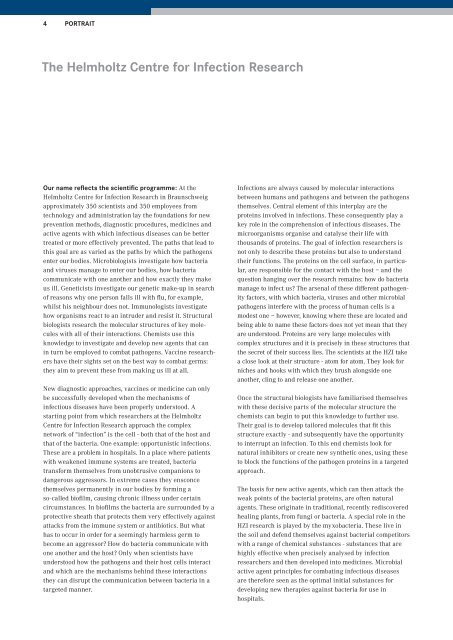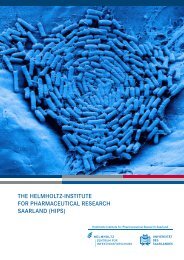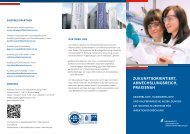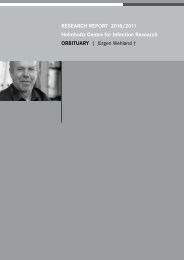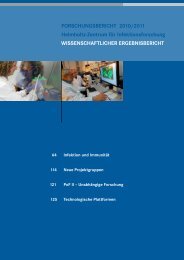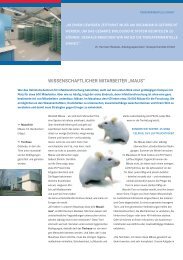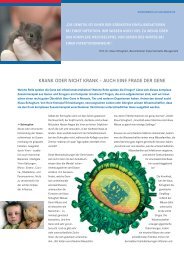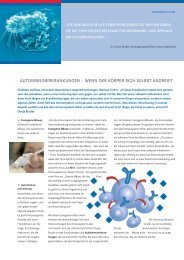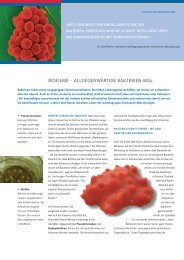Research Report 2010 2011 - Helmholtz-Zentrum für ...
Research Report 2010 2011 - Helmholtz-Zentrum für ...
Research Report 2010 2011 - Helmholtz-Zentrum für ...
You also want an ePaper? Increase the reach of your titles
YUMPU automatically turns print PDFs into web optimized ePapers that Google loves.
4 PORTRAIT<br />
The <strong>Helmholtz</strong> Centre for Infection <strong>Research</strong><br />
Our name reflects the scientific programme: At the<br />
<strong>Helmholtz</strong> Centre for Infection <strong>Research</strong> in Braunschweig<br />
approximately 350 scientists and 350 employees from<br />
technology and administration lay the foundations for new<br />
prevention methods, diagnostic procedures, medicines and<br />
active agents with which infectious diseases can be better<br />
treated or more effectively prevented. The paths that lead to<br />
this goal are as varied as the paths by which the pathogens<br />
enter our bodies. Microbiologists investigate how bacteria<br />
and viruses manage to enter our bodies, how bacteria<br />
communicate with one another and how exactly they make<br />
us ill. Geneticists investigate our genetic make-up in search<br />
of reasons why one person falls ill with flu, for example,<br />
whilst his neighbour does not. Immunologists investigate<br />
how organisms react to an intruder and resist it. Structural<br />
biologists research the molecular structures of key molecules<br />
with all of their interactions. Chemists use this<br />
knowledge to investigate and develop new agents that can<br />
in turn be employed to combat pathogens. Vaccine researchers<br />
have their sights set on the best way to combat germs:<br />
they aim to prevent these from making us ill at all.<br />
New diagnostic approaches, vaccines or medicine can only<br />
be successfully developed when the mechanisms of<br />
infectious diseases have been properly understood. A<br />
starting point from which researchers at the <strong>Helmholtz</strong><br />
Centre for Infection <strong>Research</strong> approach the complex<br />
network of “infection” is the cell - both that of the host and<br />
that of the bacteria. One example: opportunistic infections.<br />
These are a problem in hospitals. In a place where patients<br />
with weakened immune systems are treated, bacteria<br />
transform themselves from unobtrusive companions to<br />
dangerous aggressors. In extreme cases they ensconce<br />
themselves permanently in our bodies by forming a<br />
so-called biofilm, causing chronic illness under certain<br />
circumstances. In biofilms the bacteria are surrounded by a<br />
protective sheath that protects them very effectively against<br />
attacks from the immune system or antibiotics. But what<br />
has to occur in order for a seemingly harmless germ to<br />
become an aggressor? How do bacteria communicate with<br />
one another and the host? Only when scientists have<br />
understood how the pathogens and their host cells interact<br />
and which are the mechanisms behind these interactions<br />
they can disrupt the communication between bacteria in a<br />
targeted manner.<br />
Infections are always caused by molecular interactions<br />
between humans and pathogens and between the pathogens<br />
themselves. Central element of this interplay are the<br />
proteins involved in infections. These consequently play a<br />
key role in the comprehension of infectious diseases. The<br />
microorganisms organise and catalyse their life with<br />
thousands of proteins. The goal of infection researchers is<br />
not only to describe these proteins but also to understand<br />
their functions. The proteins on the cell surface, in particular,<br />
are responsible for the contact with the host – and the<br />
question hanging over the research remains: how do bacteria<br />
manage to infect us? The arsenal of these different pathogenity<br />
factors, with which bacteria, viruses and other microbial<br />
pathogens interfere with the process of human cells is a<br />
modest one – however, knowing where these are located and<br />
being able to name these factors does not yet mean that they<br />
are understood. Proteins are very large molecules with<br />
complex structures and it is precisely in these structures that<br />
the secret of their success lies. The scientists at the HZI take<br />
a close look at their structure - atom for atom. They look for<br />
niches and hooks with which they brush alongside one<br />
another, cling to and release one another.<br />
Once the structural biologists have familiarised themselves<br />
with these decisive parts of the molecular structure the<br />
chemists can begin to put this knowledge to further use.<br />
Their goal is to develop tailored molecules that fit this<br />
structure exactly - and subsequently have the opportunity<br />
to interrupt an infection. To this end chemists look for<br />
natural inhibitors or create new synthetic ones, using these<br />
to block the functions of the pathogen proteins in a targeted<br />
approach.<br />
The basis for new active agents, which can then attack the<br />
weak points of the bacterial proteins, are often natural<br />
agents. These originate in traditional, recently rediscovered<br />
healing plants, from fungi or bacteria. A special role in the<br />
HZI research is played by the myxobacteria. These live in<br />
the soil and defend themselves against bacterial com petitors<br />
with a range of chemical substances - substances that are<br />
highly effective when precisely analysed by infection<br />
researchers and then developed into medicines. Microbial<br />
active agent principles for combating infectious diseases<br />
are therefore seen as the optimal initial substances for<br />
developing new therapies against bacteria for use in<br />
hospitals.


